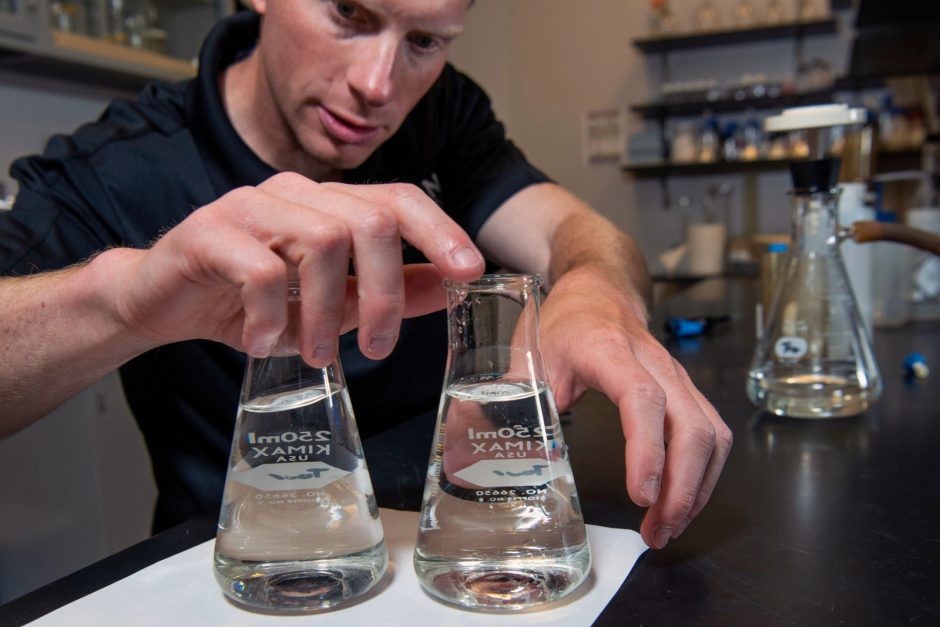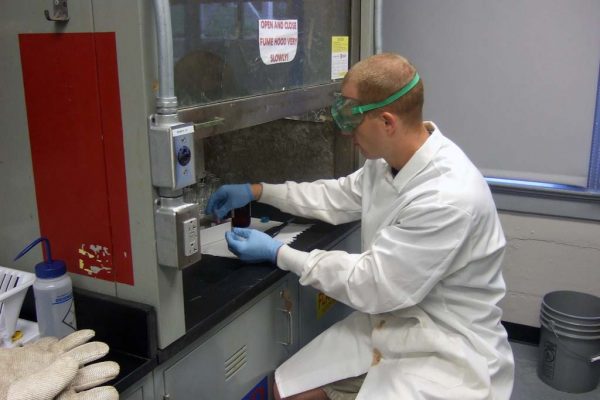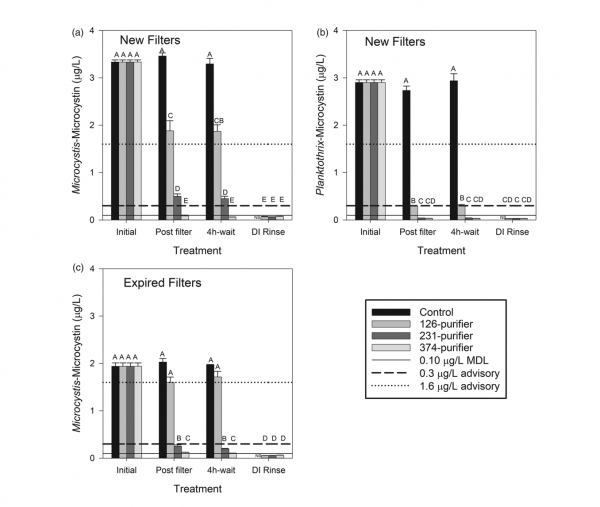Water-Filter Pitchers Not Equally Effective at Removing Microcystins

Dr. Chaffin in the lab. (Credit: Ohio Sea Grant, Stone Laboratory, https://ohioseagrant.osu.edu/news/2018/7a1my/water-quality-safe.)
Harmful algal blooms (HABs) and the toxins they produce, threaten drinking water safety worldwide, and here in the US, we are becoming more aware of the issue as HABs are reported across the country. Microcystins, the most common toxins arising from HABs, can put animals and humans at risk. Human reactions to microcystins include mild skin rash, respiratory illness, kidney or liver damage and even death.
If you use a water-filter pitcher to ensure harmful microcystins aren’t present in your drinking water, recent research has both good news and bad news for you. First, the bad news: these water-filter pitchers vary substantially in how effectively they can remove harmful contaminants. However, the good news is, with the right kind of filter cartridge, you can count on your pitcher removing 100 percent of microcystins from your water.
Putting pitchers to the test
“I initially conceived of this project because we do a lot of educational outreach activities where we talk about harmful algal blooms (HABs), and at the end of my presentation or other people’s presentations we were getting that question a lot: does my water pitcher purifier filter out microcystins? explains senior researcher and research coordinator Ohio State University’s Stone Laboratory, Dr. Justin Chaffin. And our answer was, ‘Well, I don’t know, maybe.’ So that’s what really gave me the idea to do these experiments.”
Situated on Lake Erie, Stone Lab is a scientific hub for research on challenges facing the Great Lakes—and one of the most pressing is the issue of HABs. The team decided to put the household pitcher filter to the test.
They collected samples of water from Lake Erie containing several microcystin-producing bacteria. They observed the samples under a microscope to confirm which bacteria were present. The team then lysed the cells by subjecting the water samples to three freeze/thaw cycles and extracted the microcystins, measuring the concentration. They were thus able to use water with a known concentration of specific types of microcystins with the filter cartridges.
The team tested three different brands of pitchers, each with unique filter components, and each certified by NSF International/American National Standards Institute standards #42 and #53 for aesthetic and health effects—but not for microcystins.
They poured a set quantity of contaminated water in each pitcher, measuring both percolation time and microcystin levels after percolation. They also waited and measured again to ensure there was no leaking from the filter. All three of the filters are widely commercially available.
“We used three of the very common brands you can buy at Walmart or anywhere online,” details Dr. Chaffin. “We found that one brand removes about half the toxins; another brand removes about 75 percent, and the third brand removed 100 percent of the toxins.”
Time and surface area
What makes the difference? The combination of slow filtration time and a cartridge made from a blend of activated carbon sources.
“The one that removed the most toxins had the slowest percolation rate, so there was a lot of contact time and a lot of time for the microcystins in the water to bind to the activated carbon that’s in the cartridge,” Dr. Chaffin describes. “The second thing about the cartridge that worked the best was they used several different types of activated carbon.”

Dr. Justin Chaffin of Stone Lab. (Credit: Ohio Sea Grant, Stone Laboratory, https://ohioseagrant.osu.edu/news/2015/052kc/OSG-leads-charge-against-HABs.)
Not all activated carbon is good for every organic molecule. A commonly-used type of activated carbon is coconut-based making it low cost.
“Picture a ball of activated carbon,” Dr. Chaffin elaborates. “Within that ball, there will be a bunch of crevices called pores. The coconut-based activated carbon pores are very tiny, and the microcystin molecule itself cannot fit inside those pores.”
In other words, only the surface area along the outside of that little ball of activated carbon is available to the microcystins for binding.
“In contrast, if you use wood-based or peat moss-activated carbon, that ball has much larger pores which can accommodate the microcystin molecule,” states Dr. Chaffin. “There’s a lot more surface area for absorption. So it was the combination of the larger pores in the activated carbon and the slower percolation that worked better.”
“I was surprised, and I’m glad we picked three different cartridge types,” remarks Dr. Chaffin.
Practical action
In 2014, microcystins contaminated the water supply in Toledo, Ohio, leaving more than 400,000 without running water for days. This and other recent events surrounding Lake Erie have made microcystins—and bottled water—a frequently debated topic in Ohio.
“Think of the worst case scenario: even the worst filter removed about half the toxins,” comments Dr. Chaffin. “In Toledo, since they had their drinking water crisis, a lot of the people up there no longer trust the tap water, and they buy bottled water. But bottled water is expensive, and it causes a lot of waste.”
The silver lining to the study? Even the worst pitchers provide a significant level of protection, for a low cost.
“Toxins stay in the filter,” adds Dr. Chaffin. “Once they get bound they don’t become unbound. And we didn’t find the toxins coming back out of the pitchers after they were used.”
And a good quality pitcher is a highly effective safeguard.
“If you do have some concerns about low-level toxins getting through, using one of these pictures is a more economical route than buying bottled water,” remarks Dr. Chaffin. “It adds an additional layer of protection. I wouldn’t say you can go straight to the lake and start drinking water that comes out of the pitcher. But for an additional layer of protection, the water pitchers are an effective method.”
The team is confident that consumers can rely on the findings.

Total microcystin concentration (μg/L) following percolation through pitcher-style purifiers (‘post filter’), 4 hours after percolation (‘4h-wait’), and in deionized water percolated (‘DI rinse’). Experiments were conducted with new filter cartridges with microcystins extracted from (a) Microcystis and (b) Planktothrix and (c) with expired cartridges using Microcystis-microcystins. Bars are means (±1 standard error) of three replicate pitchers. Letters above bars are Tukey test results with mean of A > B > C > D > E. Horizontal lines indicate the method detection limit, advisory level for children, and the advisory level for adults. ‘NS’ = no sample. DI water was not poured into the non-filtered controls. (Credit: https://iwaponline.com/ws/article/doi/10.2166/ws.2018.081/39220/The-ability-of-household-pitcher-style-water?searchresult=1)
“When we used different types of microcystins, we got the same results,” states Dr. Chaffin. “We repeated the experiments, and we got the same results. So the experiment worked well, and it shows you that you get what you pay for.”
Coconut-based activated carbon correlates with low cost, but even the costlier pitchers were within reach for many. The pitchers tested in the study ranged from $15 to about $50.
“I didn’t mention brands or costs in the paper itself, because different brands might have an expensive grade cartridge or they might have a cheaper grade cartridge,” cautions Dr. Chaffin. “But you don’t want a cartridge that only has coconut-based activated carbon.”
Top image: Dr. Chaffin in the lab. (Credit: Ohio Sea Grant, Stone Laboratory, https://ohioseagrant.osu.edu/news/2018/7a1my/water-quality-safe.)




Alferd Botanist
January 25, 2022 at 12:43 pm
I was working on a submerged fermentation to carry out my research work and when i prepare the inoculum there was the contamination of bacteria and i stop using the pithcher afterwards I always use the deionized water to save time and my efforts